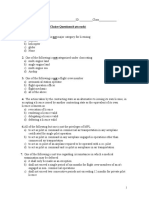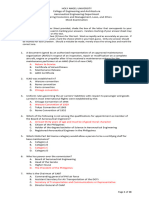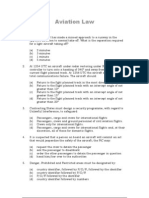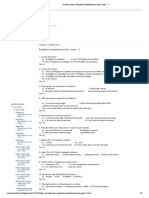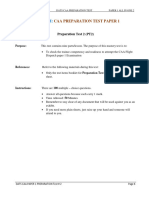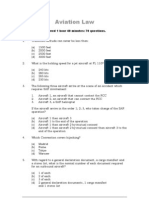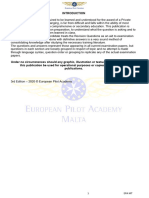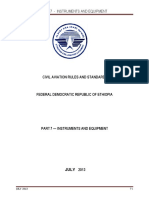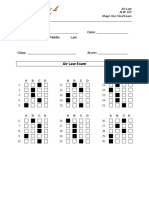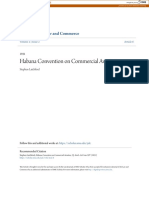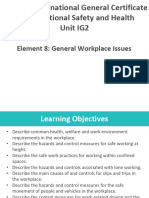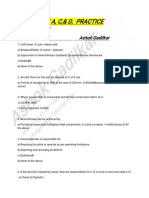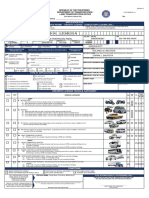Air Low Ex
Air Low Ex
Uploaded by
sadjuharCopyright:
Available Formats
Air Low Ex
Air Low Ex
Uploaded by
sadjuharOriginal Title
Copyright
Available Formats
Share this document
Did you find this document useful?
Is this content inappropriate?
Copyright:
Available Formats
Air Low Ex
Air Low Ex
Uploaded by
sadjuharCopyright:
Available Formats
Stage One - Academics
LAW 101 - Air Law
Final Exam • page 1
LAW 101 Exam
Name: __________________________________________ Date: _________________
First Middle Last
Class: __________________________________________ Score: ________________
Exam Questions
1. What were the three major Civil Aviation Conventions?
a) Paris Peace, Warsaw, and Chicago
b) Havana, Tokyo, and Chicago
c) Paris Peace, Havana, and Chicago
2. What organization was formed out of the Chicago Convention?
a) International Commission for Air Navigation (ICAN)
b) International Civil Aviation Organization (ICAO)
c) Joint Aviation Authority (JAA)
3. What does “Standard” mean in reference to ICAO law?
a) A companies Standard Operating Procedure approved by the authority
b) Application is necessary for the safety or regularity of civil aviation; compliance is
mandatory
c) Application is desirable, but not essential; application is not mandatory
4. What is NOT an objective of ICAO?
a) To ensure safe and orderly growth of international civil aviation throughout the
world
b) To encourage the arts of aircraft design and operation for peaceful purposes
c) To encourage development of waterways and navigation facilities
Version 2.0 01 March 2012
Stage One - Academics
LAW 101 - Air Law
Final Exam • page 2
5. With respect to pilot certification, which is a category of aircraft?
a) Gyroplane, helicopter, airship, free balloon
b) Airplane, rotorcraft, glider, lighter-than-air
c) Single-engine land and sea, multi-engine land and sea
6. With respect of pilot certification, which is a class of aircraft?
a) Single-engine land and sea, multi-engine land and sea
b) Airplane, rotorcraft, glider, lighter-than-air
c) Lighter-than-air, airship, hot air balloon, gas balloon
7. The pilot in command is NOT required to hold a type rating in which aircraft?
a) Aircraft certified for operation requiring at least two pilots
b) Helicopters and Power-lifts for single-pilot operations
c) To operate aircraft solely using instruments
d) Whenever the Licensing Authority considers it necessary
8. For MPL operations a Class 1 Medical Assessment issued to a 25 year old pilot
on July 15 this year, will expire
a) Midnight July 31, 12 months later
b) Midnight July 14, 6 months later
c) Midnight July 14, 12 months later
9. What is the duration of a Class 1 Medical Assessment issued to a 60 year old
pilot?
a) 6 months
b) 12 months
c) 24 months
d) 60 months
Version 2.0 01 March 2012
Stage One - Academics
LAW 101 - Air Law
Final Exam • page 3
10. Which of the following is not a pilot license:
a) Private pilot
b) Commercial pilot
c) Instrument pilot
d) Airline Transport Pilot
11. What is the age requirement for a Multi-Crew Pilot License?
a) 17
b) 18
c) 19
d) 21
12. Refer to Figure 1. Which symbol indicates a taxiway/taxiway intersection
hold position marking?
a) A
b) D
c) E
13. Refer to Figure 2. Area C on the airport depicted is classified as a
a) Stabilized area
b) Multiple heliport
c) Closed runway
14. What color are runway end lights?
a) Green at approach end and red at opposite end
b) White
c) Alternating red and white
Version 2.0 01 March 2012
Stage One - Academics
LAW 101 - Air Law
Final Exam • page 4
15. Refer to Figure 2. That portion of the runway identified by the letter A may be
used for
a) Landing (touchdown)
b) Taxiing, takeoff, and landing (touchdown)
c) Taxiing , takeoff, and landing (roll-out)
16. Refer to Figure 3. The segmented circle indicates the airport traffic is
a) Left-hand for Runway 36 and right-hand for Runway 18
b) Left-hand for Runway 18 and right-hand for Runway 36
c) Right-hand for Runway 9 and left-hand for Runway 27
17. Refer to Figure 4. Illustration A indicates that the aeroplane is
a) Below the glide slope
b) On the glide slope
c) Above the glide slope
18. Refer to Figure 5. Select the proper traffic pattern and runway for landing.
a) Left-hand traffic and Runway 18
b) Right-hand traffic and Runway 18
c) Left-hand traffic and Runway 22
19. Aerodrome taxiway edge lights are identified at night by
a) White lights
b) Blue lights
c) Alternate yellow and green lights
20. Refer to Figure 6. What does the sign indicate?
a) Runway 4
b) 400 feet remaining on runway
c) 4,000 feet remaining on runway
Version 2.0 01 March 2012
Stage One - Academics
LAW 101 - Air Law
Final Exam • page 5
21. Which aircraft has right-of-way over all other air traffic?
a) Balloon
b) Aircraft in distress
c) Aircraft on final approach to land
22. Which aircraft has the right-of way over the other aircraft listed?
a) Glider
b) Airship
c) Aeroplane
23. What is the minimum safe altitude to operate an aeroplane at over a
populated area?
a) 500 feet
b) At an altitude that will allow a safe landing if an emergency occurs
c) 1000 feet
24. Most midair collision accidents occur during
a) Hazy days
b) Clear days
c) Cloudy nights
25. How can you determine if another aircraft is on a collision course with your
aircraft?
a) The other aircraft will always appear to get larger and closer at a rapid rate
b) The nose of each aircraft is pointed at the same point in space
c) There will be no apparent relative motion between your aircraft and the other
aircraft
Version 2.0 01 March 2012
Stage One - Academics
LAW 101 - Air Law
Final Exam • page 6
26. Aircraft design blind spots are especially dangerous when:
a) A high wing aircraft is descending with a low wing aircraft climbing
b) A high wing aircraft turning and a low wing aircraft climbing
c) A high wing aircraft climbing and a low wing aircraft descending
27. When operating in Class A Airspace what is the maximum airspeed you can
operate at?
a) Maximum airspeed of 250 knots
b) No airspeed restriction
c) Maximum airspeed of 200 knots
28. When operating under VFR flight rules continuous two way radio
communication is required?
a) Class G airspace
b) Class E airspace
c) Class C airspace
29. When operating VFR in Class D airspace below 10,000 ft. what is the flight
visibility required?
a) 5 km
b) 10km
c) 8km
30. What is the flight visibility requirement above 10,000 ft. in Class E airspace?
a) 8km
b) 5km
c) 10km
Version 2.0 01 March 2012
Air Law
ALW 101
Stage One - Academics
LAW 101 - Air Law
Stage One Final
Final Exam
Exam • page 7
Figure 1 Figure 2
01 October 2011 - Version 1.0 Page 9
Version 2.0 01 March 2012
Air Law
Stage One - Academics
ALW 101
LAW 101 - Air Law
Final
Stage OneExam page 8
Final•Exam
Figure 3 Figure 4
4
Figure 6
Figure 5
01 October 2011 - Version 1.0 Page 10
Version 2.0 01 March 2012
You might also like
- Typical Exam QuestionsDocument13 pagesTypical Exam QuestionsIrwansyahIwanPankep100% (5)
- CT16 CT18 Operating ManualDocument130 pagesCT16 CT18 Operating ManualTSPSRL Import ExportNo ratings yet
- PPL Q. Bank (Al)Document30 pagesPPL Q. Bank (Al)Sabik Rahim67% (3)
- Drone MCQDocument14 pagesDrone MCQSrikumar T B100% (4)
- Final Test For CAA MPLDocument8 pagesFinal Test For CAA MPLsadjuharNo ratings yet
- 1 - CPL Questions Air LawDocument103 pages1 - CPL Questions Air LawThunder BladeNo ratings yet
- Air Law Q1Document9 pagesAir Law Q1Iludiran KolaNo ratings yet
- 1 - ATPL Questions Air LawDocument104 pages1 - ATPL Questions Air LawTanvir Hasan100% (2)
- CPL Question Bank Air Law PDFDocument103 pagesCPL Question Bank Air Law PDFКирилл ДивисенкоNo ratings yet
- BCE 312 (Highway and Railroad Engineering) SIM SDL (Week 1-3)Document45 pagesBCE 312 (Highway and Railroad Engineering) SIM SDL (Week 1-3)Lee-an AnayonNo ratings yet
- QUIZ LAW 101 Air Law QuizDocument3 pagesQUIZ LAW 101 Air Law QuizsadjuharNo ratings yet
- Phase 1 Air Law Final Exam KeyDocument6 pagesPhase 1 Air Law Final Exam KeysadjuharNo ratings yet
- Exam LAW 101 Air Law Quiz Final Rev 1 (1) - 1Document3 pagesExam LAW 101 Air Law Quiz Final Rev 1 (1) - 1ibrahim abdiNo ratings yet
- Airlaw 2Document9 pagesAirlaw 2Kola IludiranNo ratings yet
- ExamDocument3 pagesExamDawitNo ratings yet
- Exam Questions For Obtaining Aircraft Licenses and Ratings: PPL (A) - Operational ProceduresDocument25 pagesExam Questions For Obtaining Aircraft Licenses and Ratings: PPL (A) - Operational ProceduresDejan PavlovićNo ratings yet
- Drone Pilot TrainingDocument18 pagesDrone Pilot TrainingDhanush A NNo ratings yet
- Regs Test-1 (KEY)Document12 pagesRegs Test-1 (KEY)rona putriNo ratings yet
- Unit Test 1201 StudentDocument8 pagesUnit Test 1201 StudentAkshay MaheshwariNo ratings yet
- CAT II-III Examination Questionaire - AUG 2021Document3 pagesCAT II-III Examination Questionaire - AUG 2021Vu Nguyen TuanNo ratings yet
- PPL Airlaw CatDocument6 pagesPPL Airlaw CatJames KariukiNo ratings yet
- Exam Questions For Obtaining Aircraft Licenses and Ratings: PPL (A) - Operational ProceduresDocument0 pagesExam Questions For Obtaining Aircraft Licenses and Ratings: PPL (A) - Operational ProceduresJose DiasNo ratings yet
- Answerkey EngrEcoLawsEthics - MockExamActivity-july 2019Document18 pagesAnswerkey EngrEcoLawsEthics - MockExamActivity-july 2019Lem TanhuecoNo ratings yet
- AE8302-Elements of Aeronautical Engineering: Reg. NoDocument2 pagesAE8302-Elements of Aeronautical Engineering: Reg. NoViswanath ViswaNo ratings yet
- Test 1Document4 pagesTest 1m24tzfbrzmNo ratings yet
- Avionics Questions and AnswersDocument2 pagesAvionics Questions and AnswersnanthakumarmaniNo ratings yet
- Law Feedback Paper 3Document12 pagesLaw Feedback Paper 3momanbhNo ratings yet
- IATADocument19 pagesIATAhimarajasekharanNo ratings yet
- What Is Special VFRDocument9 pagesWhat Is Special VFRYadi BoparaiNo ratings yet
- Aviation Study - Regulation Miscellaneous Que. Paper - 3Document4 pagesAviation Study - Regulation Miscellaneous Que. Paper - 3parul sharmaNo ratings yet
- Question Paper 5Document9 pagesQuestion Paper 5Rishabh KumarNo ratings yet
- Aviation Exam Questions and Answers PDFDocument2 pagesAviation Exam Questions and Answers PDFpankajhasanpuraNo ratings yet
- Pooley SDocument83 pagesPooley SPratham SinhaNo ratings yet
- Complete TEST No 3Document10 pagesComplete TEST No 3rohitNo ratings yet
- Vas QP Ia 3Document4 pagesVas QP Ia 3Chand OfficialNo ratings yet
- Paper 1 All in One 2 With AnsDocument16 pagesPaper 1 All in One 2 With Ansbabasadique78No ratings yet
- Air LawDocument89 pagesAir LawRitwik ChowdhuryNo ratings yet
- Law Exam 2Document14 pagesLaw Exam 2momanbh100% (2)
- FPPL 46 QuestionsDocument5 pagesFPPL 46 QuestionsteohwkNo ratings yet
- Atpl Air Law Gen Practice QuesDocument19 pagesAtpl Air Law Gen Practice QuesKola IludiranNo ratings yet
- 1 Atpl Air LawDocument8 pages1 Atpl Air LawAlawy AlathrusNo ratings yet
- W31 - TUTORIAL - Air Law Practice QuizDocument8 pagesW31 - TUTORIAL - Air Law Practice QuizfedorovmichealNo ratings yet
- Air Regulation Dgca Question PaperDocument8 pagesAir Regulation Dgca Question PaperprachatNo ratings yet
- East African School of Aviation Examinations: Final Exam Safety SectionDocument6 pagesEast African School of Aviation Examinations: Final Exam Safety SectionLazaro LarryNo ratings yet
- Regulations - Revision Paper - 3Document7 pagesRegulations - Revision Paper - 3Prajwal SridharNo ratings yet
- Soal Airlaw Uts d3 PST 3Document6 pagesSoal Airlaw Uts d3 PST 3Azuma Cenation AzraNo ratings yet
- Regs Assessment12Document17 pagesRegs Assessment12arvindNo ratings yet
- Law Feedback Paper 1Document12 pagesLaw Feedback Paper 1momanbhNo ratings yet
- Regulations OLODE 04 2024 30th MayDocument7 pagesRegulations OLODE 04 2024 30th Maysreeramroutoneofakind443No ratings yet
- Abnormal EventDocument2 pagesAbnormal EventMuhammad Haizul RashidNo ratings yet
- PPLHAVUZSONHALİDocument211 pagesPPLHAVUZSONHALİerucartNo ratings yet
- PPLQuestion Book 2Document283 pagesPPLQuestion Book 2Wales MatthewNo ratings yet
- Aviation Study - Regulation Miscellaneous Que. Paper - 4Document4 pagesAviation Study - Regulation Miscellaneous Que. Paper - 4parul sharmaNo ratings yet
- Atm QuestionDocument6 pagesAtm Questionvijay LalamNo ratings yet
- A320 - Operational QuestionDocument68 pagesA320 - Operational QuestionYobani HuancaNo ratings yet
- Pilot's Handbook of Aeronautical Knowledge (2024): FAA-H-8083-25CFrom EverandPilot's Handbook of Aeronautical Knowledge (2024): FAA-H-8083-25CNo ratings yet
- Small Unmanned Fixed-wing Aircraft Design: A Practical ApproachFrom EverandSmall Unmanned Fixed-wing Aircraft Design: A Practical ApproachNo ratings yet
- Mechanical Engineering at the National Research Council of Canada: 1929-1951From EverandMechanical Engineering at the National Research Council of Canada: 1929-1951No ratings yet
- Sense and Avoid in UAS: Research and ApplicationsFrom EverandSense and Avoid in UAS: Research and ApplicationsRating: 5 out of 5 stars5/5 (1)
- Airport Economics in Latin America and the Caribbean: Benchmarking, Regulation, and PricingFrom EverandAirport Economics in Latin America and the Caribbean: Benchmarking, Regulation, and PricingNo ratings yet
- Part 7Document78 pagesPart 7sadjuharNo ratings yet
- Part 2Document335 pagesPart 2sadjuhar0% (1)
- EDDFDocument181 pagesEDDFsadjuharNo ratings yet
- Part 5Document56 pagesPart 5sadjuharNo ratings yet
- HECADocument29 pagesHECAsadjuharNo ratings yet
- HDAMDocument20 pagesHDAMsadjuharNo ratings yet
- ALW 101 Air Law Final Exam Answer Sheet KeyDocument1 pageALW 101 Air Law Final Exam Answer Sheet KeysadjuharNo ratings yet
- Ip 13Document8 pagesIp 13sadjuharNo ratings yet
- Habana Convention On Commercial Aviation: Journal of Air Law and CommerceDocument5 pagesHabana Convention On Commercial Aviation: Journal of Air Law and CommercesadjuharNo ratings yet
- IG2 Element 8Document103 pagesIG2 Element 8Christine IreshaNo ratings yet
- Individual Motorbikes Should Be Banned in The Centre of HCM CityDocument7 pagesIndividual Motorbikes Should Be Banned in The Centre of HCM CityNgọc VõNo ratings yet
- Deploymentof ITSin PakistanDocument13 pagesDeploymentof ITSin PakistanAwanNo ratings yet
- Airport Security TechnologiesDocument5 pagesAirport Security TechnologieselviNo ratings yet
- Toolbox: Fatigue: The Hidden KillerDocument10 pagesToolbox: Fatigue: The Hidden KillerAfroz AlamNo ratings yet
- Risks, Damages, and Accidents of Maritime Commerce Averages ARTICLE 806Document5 pagesRisks, Damages, and Accidents of Maritime Commerce Averages ARTICLE 806Shasharu Fei-fei LimNo ratings yet
- Car Series A, C,& D, Practice QuestionsDocument26 pagesCar Series A, C,& D, Practice QuestionsVijaya shelarNo ratings yet
- Madam Rides The Bus NotesDocument7 pagesMadam Rides The Bus NotesMOHAMED NIYASNo ratings yet
- Vietnam Traffic RulesDocument27 pagesVietnam Traffic Ruleskyawt kyawtNo ratings yet
- Aircraft Maintenance AssignmentDocument10 pagesAircraft Maintenance AssignmentThanas rubhenNo ratings yet
- Hardware Implementation of Automatic Side Stand For Motor BikeDocument4 pagesHardware Implementation of Automatic Side Stand For Motor Bikesabeeh WaqasNo ratings yet
- Kaptan.1.Zabit 7denizcilik İngilizcesiDocument3 pagesKaptan.1.Zabit 7denizcilik İngilizcesiAliNo ratings yet
- Rev.1 ATCT-course OutlineDocument4 pagesRev.1 ATCT-course OutlineMannie VasquezNo ratings yet
- ThesisDocument41 pagesThesispriyanka priyontiNo ratings yet
- 1996 GEO TrackerDocument387 pages1996 GEO TrackerARTURO FLORESNo ratings yet
- NTSB Report WPR18FA119 PA-24 Crash 04/09/2018Document3 pagesNTSB Report WPR18FA119 PA-24 Crash 04/09/2018steve bannonNo ratings yet
- FY22 Emergency Evacuation Procedures Test With AnswersDocument12 pagesFY22 Emergency Evacuation Procedures Test With AnswersEHS Officer Danat AlainNo ratings yet
- APL-Form v3Document2 pagesAPL-Form v3Annknown artNo ratings yet
- Driver SafetyDocument16 pagesDriver Safetysalman ahmadNo ratings yet
- Tugas Pekan 6 Main Idea Part 1Document3 pagesTugas Pekan 6 Main Idea Part 1putri rfaaNo ratings yet
- Draft JMP Rig MobDocument28 pagesDraft JMP Rig MobHSE PT. GROGOL SARANA TRANSJAYANo ratings yet
- DLL-G9-7E's - Lesson 8 Part 2Document2 pagesDLL-G9-7E's - Lesson 8 Part 2Kristine Ross PelaezNo ratings yet
- Introduction To Commercial Aviation SafetyDocument3 pagesIntroduction To Commercial Aviation SafetyJohn Robyn HernandezNo ratings yet
- UMB Ai El Ectr IC TRA NSP ORTDocument37 pagesUMB Ai El Ectr IC TRA NSP ORTAnkit GhagareNo ratings yet
- NA+A1 2014 To BS EN 1991-1-7 2006+A1 2014 (Inc Corr Aug 2014 Nov 2015)Document20 pagesNA+A1 2014 To BS EN 1991-1-7 2006+A1 2014 (Inc Corr Aug 2014 Nov 2015)yadav04_abhishek100% (1)
- Accepted Manuscript: Accident Analysis and PreventionDocument20 pagesAccepted Manuscript: Accident Analysis and PreventionHasmar HalimNo ratings yet
- Urban Transportation Planning: Topic:IntroductionDocument14 pagesUrban Transportation Planning: Topic:IntroductionSesay AlieuNo ratings yet
- Hitachi Zaxis 330 3 Class Technical Manual TroubleshootingDocument20 pagesHitachi Zaxis 330 3 Class Technical Manual Troubleshootingjose98% (43)




